What Is User Generated Content? Plus Examples and Strategies
Your customers are smart and know that most branded messages are biased.
Therefore, customers tend to trust recommendations from third parties more than promotional messages directly from brands.
This is why user generated content is one of the most effective marketing channels.
In this post, we’ll define user generated content, explore its benefits, and walk through examples and forms of user generated content.
What Is User Generated Content and Where Does It Come From?
User generated content (UGC) is a form of content (text, video, audio, etc.) that discusses a product, service, or brand, yet it is created and published by a third party other than the brand itself.
Some examples of third parties who may create and publish user generated content include:
-
Influencers and creators.
-
Employees.
-
Loyalists (fans of the brand).
-
Customers.
Third-party users aren't necessarily unbiased, as they could be employees associated with the brand or influencers paid by the brand to promote the product/service. Still, user generated content is typically viewed as more credible since it is published by a third party rather than the brand itself.
To help you visualize user generated content, check out the example below. In this case, a coach is reviewing a tool he uses to run his coaching business and provides tips to use it effectively:

Source: Dustin Howes
As you can see, this post was created and published by a creator with no vested interest in the company, making the promotion more authentic and credible than a branded message.
Benefits of User Generated Content
Many brands are seeing a higher return on investment (ROI) from user generated content than branded content, and below we’ll discuss a few reasons why user generated content performs so well.
Increases Conversion Rates
As users tend to trust other third parties more than messages produced by the brand, it's no surprise that user generated content tends to convert higher than branded content.
In addition, user generated content is much more relatable.
If potential customers see how another person with similar challenges solved those problems with this product or service, it makes the value of the product or service much more realistic than a branded message telling the reader about the benefits.
Builds Trust and Credibility
You're much more likely to take the advice of a friend who you know has your best interests at heart than a brand whose agenda is clearly to make more money.
Even if the third party who is publishing the user generated content is paid for the promotion, their audience still realizes that it's in the individual's best interest to only promote products and services that are genuinely beneficial. If they don’t, they’ll lose the audience's trust (and ultimately, their income).
Therefore, user generated content makes it easier for interested potential customers to trust your brand quickly.
Reaches New High Quality Audiences
User generated content places your brand in front of the individual creator's network, making it an incredibly effective method to reach new audiences.
These audiences also tend to have your ideal prospects because the person sharing the content would only share it if they believed that doing so would be helpful to their network. Remember that individuals publishing user generated content also want to be viewed as a helpful, valuable resource by their network. So, they're unlikely to publish the content if they believe their audience wouldn't benefit from your product or service.
In addition, many people are conditioned to immediately scroll past branded messages and only engage with content from individuals that they trust. Therefore, you're more likely to grab the attention of new prospects through a third party that they already know and like.
Cost Effective Promotion
Reaching new potential customers typically requires you to either pay a platform to show ads to potential customers or spend money creating quality content to attract potential customers organically.
Either way, you typically must invest financial resources to reach new prospects.
User generated content is an exception as the user creates and publishes the content themselves. While you can pay an influencer to create user generated content, most organic user generated content is completely free for the brand.
Community Growth
When potential customers see other people just like them using your product or service, building a community around your brand is easier.
Instead of a faceless brand name, user generated content helps your brand become a hub for your ideal customers to connect and associate themselves with other like-minded people and experts.
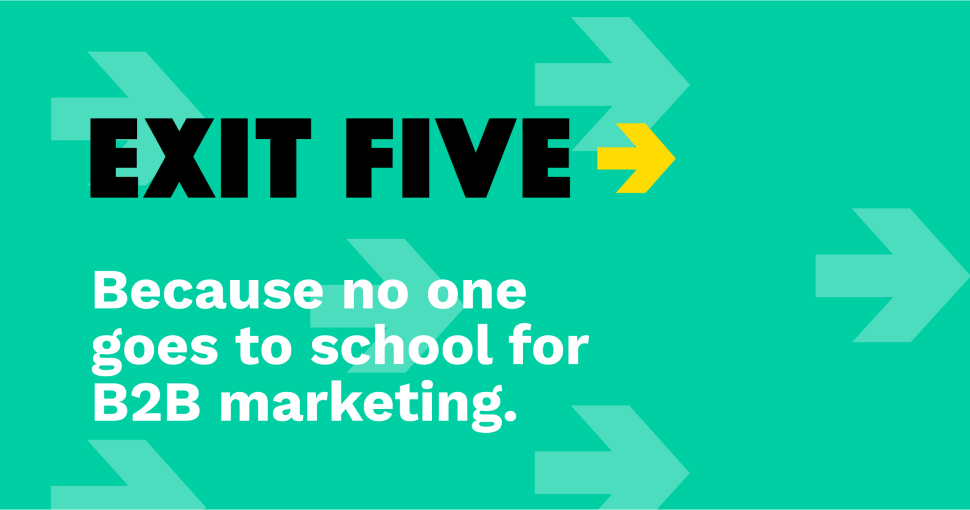
Source: Exit Five
This is why communities and brands like Exit Five are so successful. Founded on the idea that ‘no one goes to school for B2B marketing,’ the community was founded on the concept that B2B marketers often share with other B2B marketers what is working best for them. It also fuels a cost effective promotion for companies that want to market to high-level marketers as they are receptive and in a place of trust.
Content Repurposing Opportunities
We already mentioned that user generated content is a cost effective method to get in front of your target audience. However, you can also repurpose the content published by users for your own marketing materials (if you receive the creator's permission).
For example, you can take a quote from a video published by a user and include it as a testimonial on your website or use it as the creative for a new ad campaign.
Types of User Generated Content
User generated content can be any form of content, from video and audio to text and images. Here are just a few examples of user generated content in various formats.
Video
- Video testimonial/product review.
- YouTube video.
- Short form social media video (TikTok, Reels, and YouTube shorts).
- Live streams.
Audio
- Podcast mentions.
- Radio mentions.
Text
- Written social media posts (employee advocacy, customer mention, etc.).
- Written testimonials.
- Blog posts.
Images
- Infographics.
- Social media graphics.
Examples of User Generated Content
To help you visualize user generated content, here are a few examples of it across B2B, B2C, and nonprofit organizations.
B2B User Generated Content
Below we’ll explore a few different examples of highly effective B2B user generated content.
Example #1: Employee Advocacy
Employee advocacy is an excellent form of user generated content as it builds trust with the audience by putting a face to the brand.
An excellent example of a highly effective employee advocate is Daniel Berk, the Business Development Lead at beehiiv.
If you scroll through his LinkedIn profile, you’ll see that most of his posts are about something related to beehiiv’s growth, mission, or projects. It’s evident that he truly believes in beehiiv’s mission and loves working at the company.
A few styles of user generated content that he often produces include:
- Memes regarding beehiiv.
- Sharing product updates from the brand page.
- Sharing content from the founder/CEO.
- Creating content about his personal experiences working at beehiiv.
Here are a few examples of these posts:
Memes
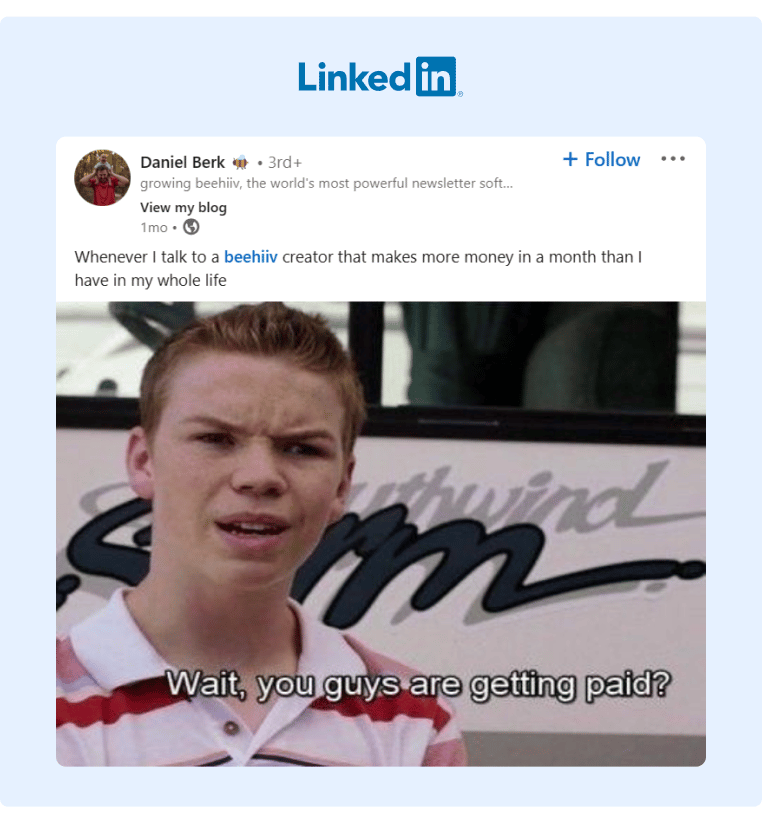 Source: Daniel Berk
Source: Daniel Berk
Product Updates
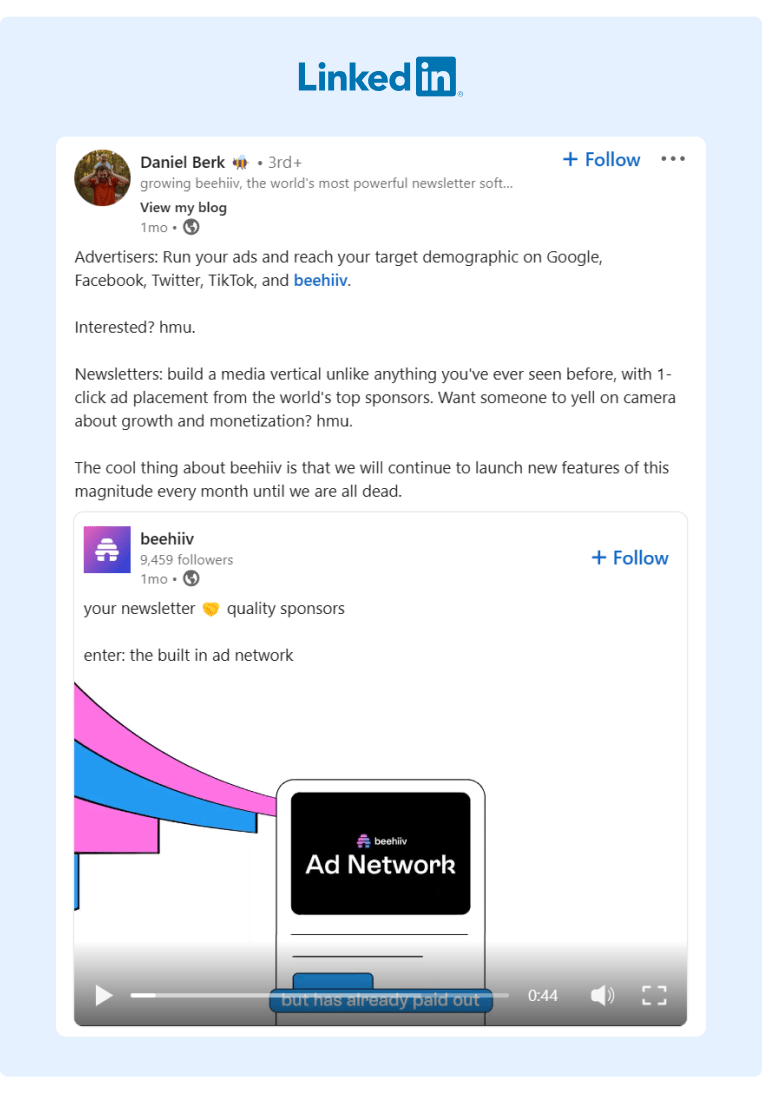
Source: Daniel Berk
Personal Stories of Working at beehiiv
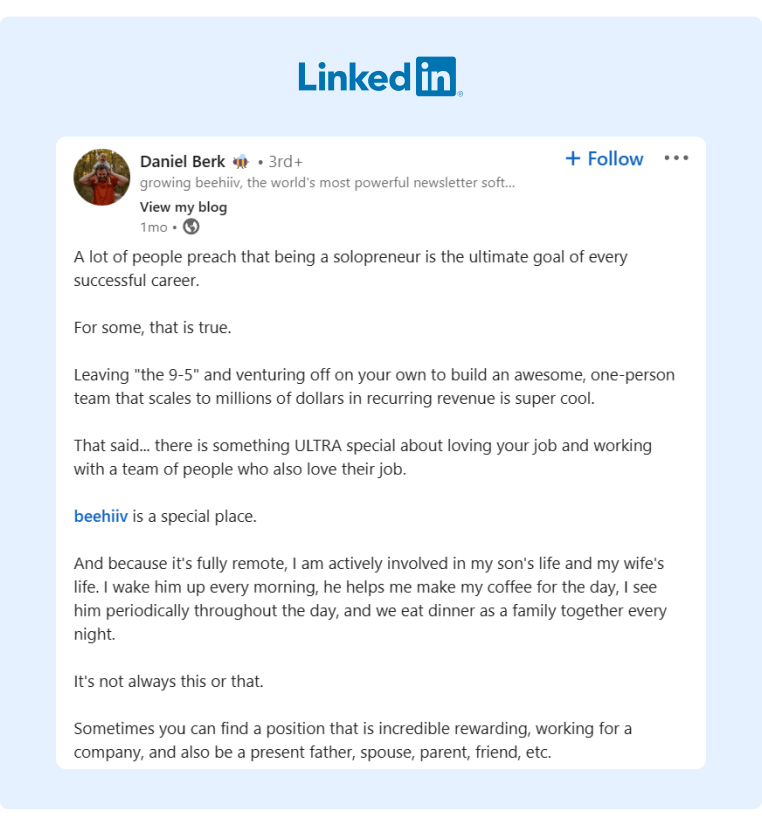
Source: Daniel Berk
Engaging With the CEO’s Content
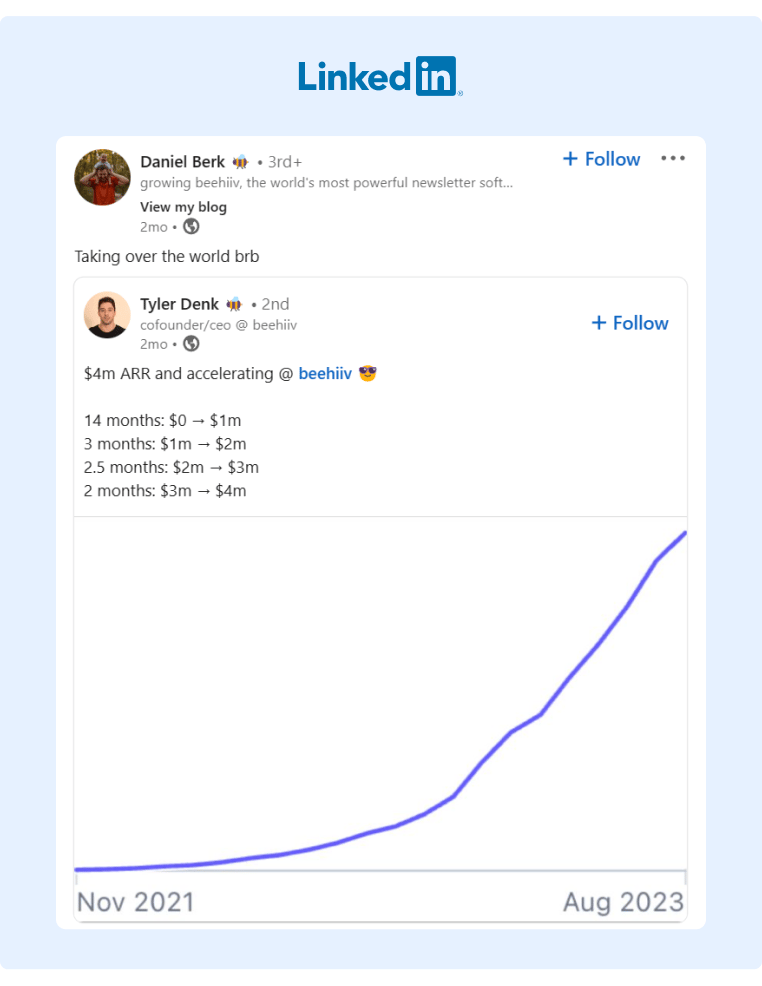
Source: Daniel Berk
Even though all of the content above is published by an employee at the company, it still has a humanistic touch that makes it much more credible and engaging than a post published by a faceless brand.
To duplicate this strategy, use an employee advocacy tool like GaggleAMP to assign engagement activities at scale. For example, you can ask them to share a new product launch, engage with content published by the CEO, or write their own posts about what they enjoy most about working for the brand.
Example #2: Customer Created Social Media Post
If you have a software tool, organic social media content published by a customer or fan is one of the best forms of user generated content.
Below is an excellent example of this style of user generated content.
In the social media post, the Ahrefs customer provides helpful tips on how marketers can use Ahrefs to execute keyword research effectively.
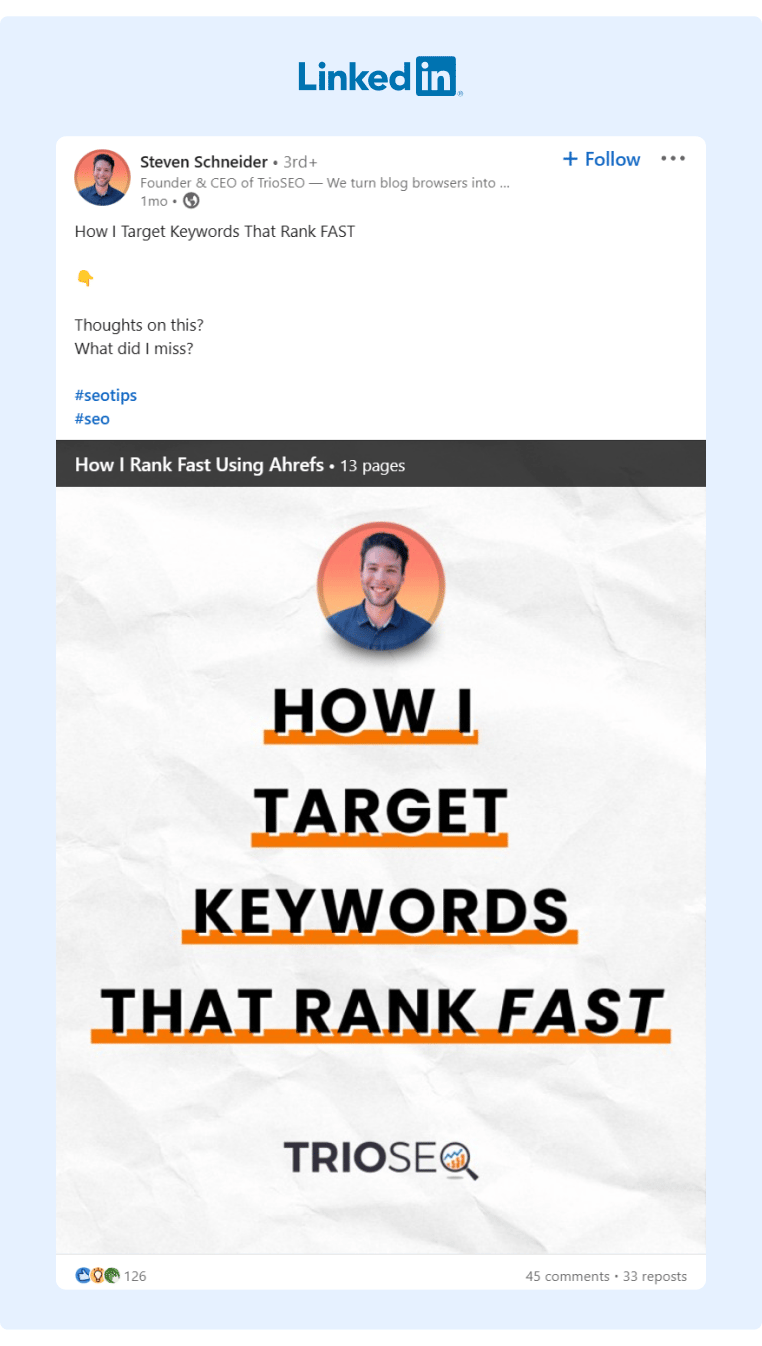
Source: Steven Schneider
This post adds credibility to Ahrefs and can lead to sales as Steven's audience can see how the tool helps them solve their main pain point.
To encourage more of this type of user generated content, consider incorporating pain point content into your content marketing strategy to educate your audience on how to more effectively use your tool.
B2C User Generated Content
Example #1: Social Media Contest
GoPro is the master of B2C user generated content. They run social media contests where people can post a video shot with one of the GoPro video products and enter the contest by using a specific hashtag in their content.
These contests have helped GoPro earn millions of views, and the content these creators publish is incredibly high quality. Not only do these contests help GoPro earn more brand awareness and social media followers, but they can also be repurposed as marketing content for the brand.
Here’s just one example of a great piece of user generated content from a GoPro user: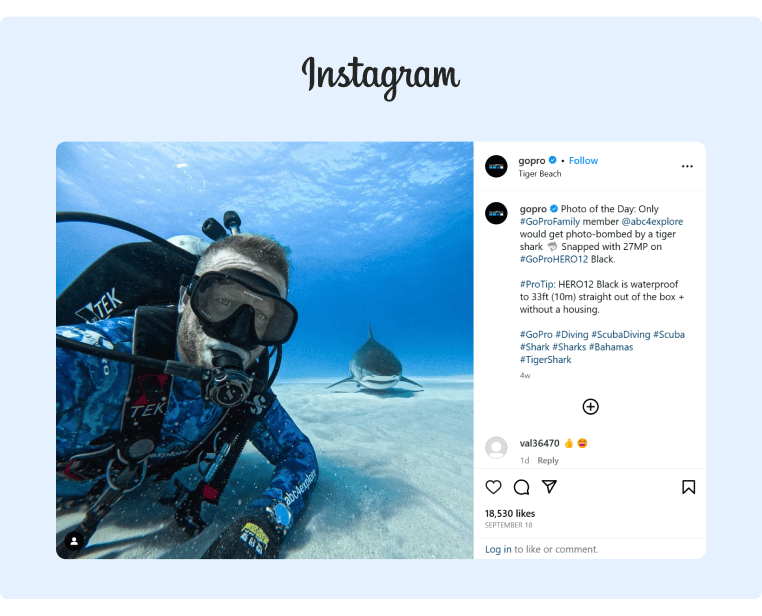
Source: GoPro
Creating content like this would typically cost the brand thousands of dollars, but in this case, GoPro gets thousands of these videos and pictures for free.
If you want to duplicate their strategy, create a social media contest that requires contestants to post a video or image of them using your product with a specific hashtag. Then, you can offer a prize to the post that you like the most.
Example #2: Influencer Content
The Nuna Stroller brand is growing rapidly. In fact, the brand name currently generates over 110,000 monthly searches and is at a growth rate of 232%.
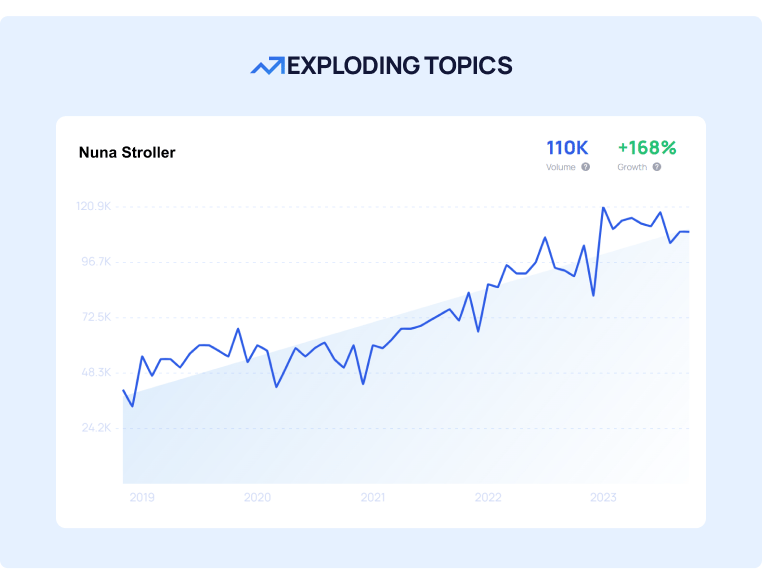
This astounding growth is largely thanks to user generated social media influencer content.
Here are just a few top TikTok videos created by influencers with hundreds of thousands, if not millions, of views.
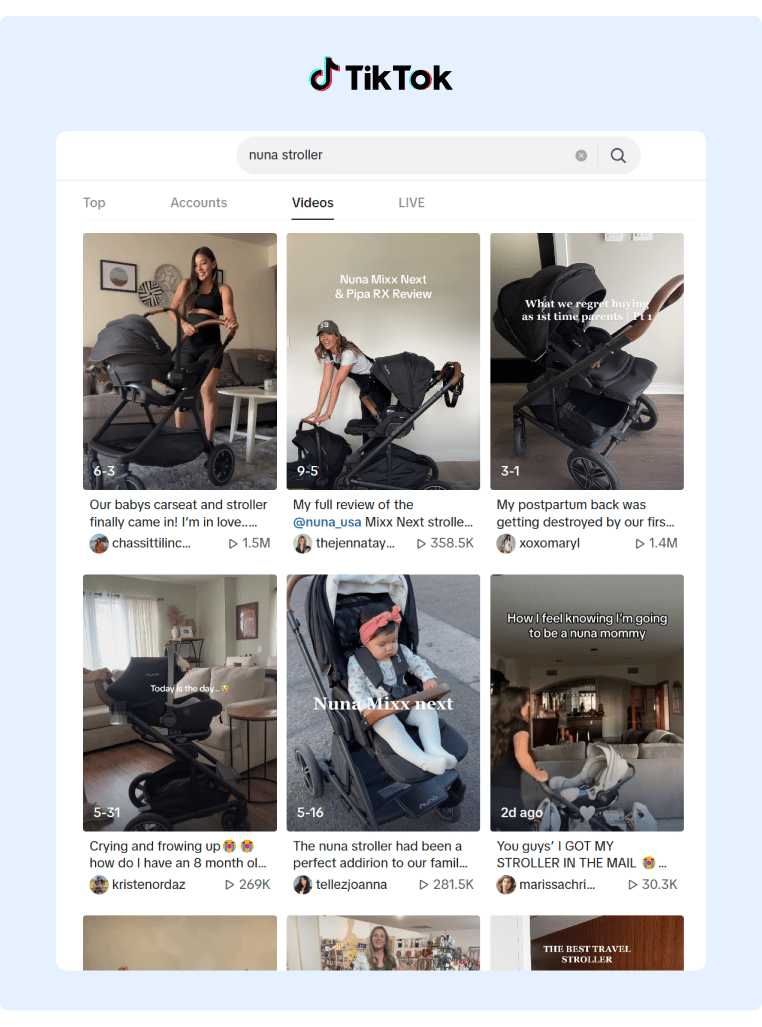
Source: TikTok Nuna Strollers
They also frequently collaborate with influencers to encourage other influencers to organically create content around the brand.
For example, if you look at Nuna Stroller's Instagram page, you'll see that most of their content is user generated influencer content (many of which are likely paid promotion):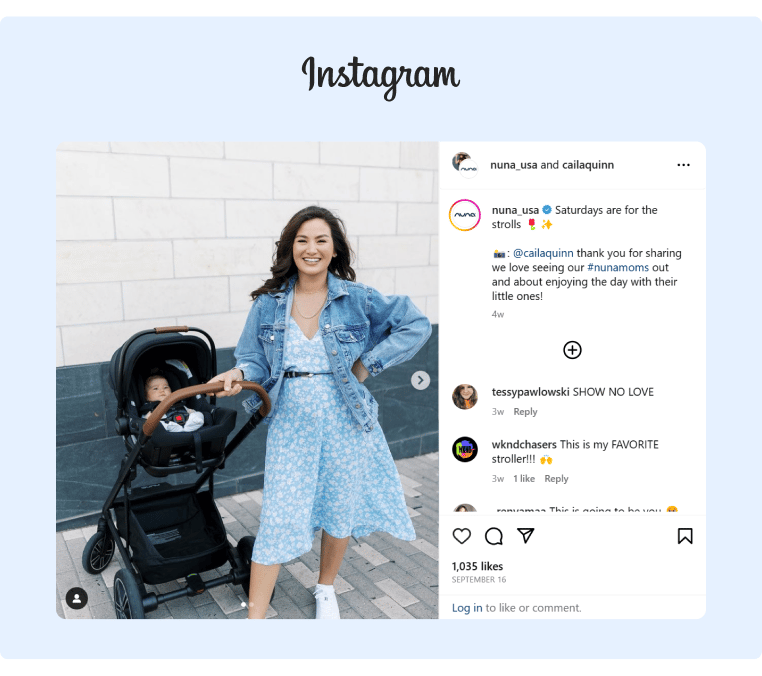
Source: Nuna Strollers
When other influencers see that their fellow influencers are discussing the Nuna Strollers, they’re more likely to create their own organic content around the brand simply because the Nuna Stroller brand is now a trending topic.
Nonprofit User Generated Content
Example #1: Volunteer Social Media Post
Everyone loves to feel useful and contribute to a good cause, so encouraging users to share content about your nonprofit is fairly easy. The key is to tell them how to share content about your nonprofit, as some volunteers worry that posting about how they volunteered will make them seem superficial.
A great hack is to ask volunteers to share what they're doing with your nonprofit and then tell them how they can let others know how they can also contribute to the mission.
This post from an influencer aiding the American Red Cross is an excellent example of user generated content: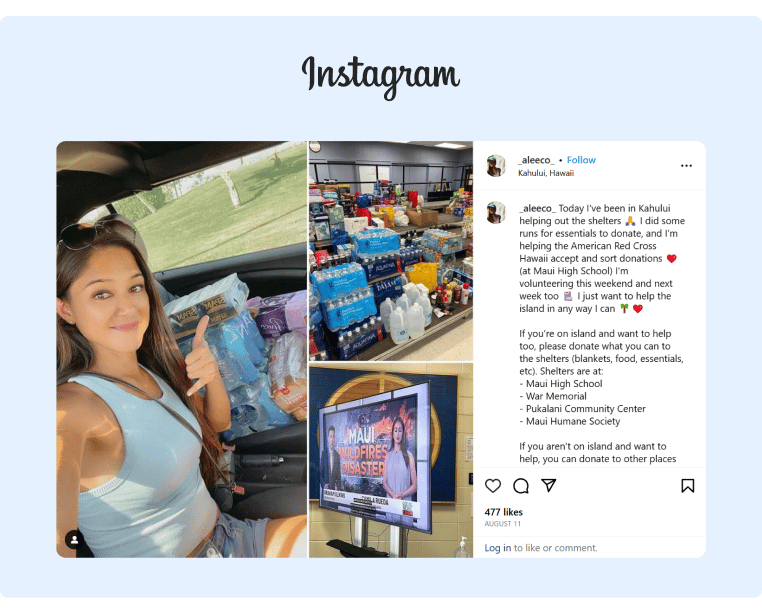
Source: Aleeco
Example #2: Influencer Partnerships
As a nonprofit, you can also partner with influencers to bring awareness to your mission through user generated content.
Here’s an excellent example of how influencer Cristo Fernandez helped UNICEF earn more brand awareness:
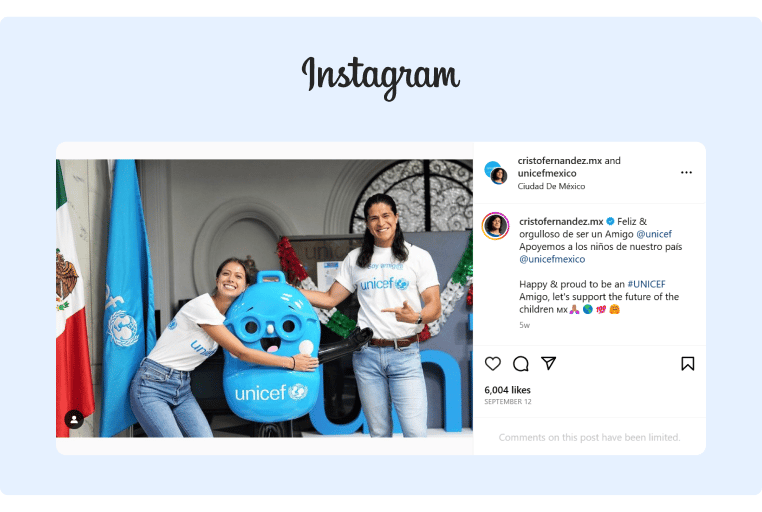
Source: Cristo Fernandez
To reach these influencers, consider using a charity or fundraising platform, like iWave, to identify people who have an affinity for your brand’s mission and try to get them actively involved in the mission.
They're more likely to post about it on social media if they're actively involved and participating in your brand’s mission.
User Generated Content in Marketing
You can’t force users to create content around your brand, but you can design a strategy to incentivize them to talk about your brand. Below, we’ll discuss how to design a strategy to encourage user generated content.
Step 1: Kickstart User Generated Campaigns With Content Partners
People like to discuss trending topics, so the best way to get more people to talk about your brand is to make it a trending topic.
To make your brand a trending topic, you can identify content partners to share content about your brand. Here are a few different content partners that you can enlist to help you:
-
Influencers: You can pay them to create content using your brand.
-
Employees: You can ask them to create content about projects they're working on and their daily experience working at your brand. You can also incentivize them to share content.
-
Investors: If you have stakeholders or investors, ask them to share your brand's mission and, if they're using it, how it helps them on a daily basis. Here's a great example of how an investor created content around a brand that they invested in.
-
Partners: If you have partnerships with parallel brands, you can ask them to create content around how people can use both your brand and their brand together.
Step 2: Incentivize Customers and Influencers To Create Organic Content
As content partners begin discussing your brand, your brand will soon become a trending topic in the industry. Once your brand is viewed as a trend, you'll find that other influencers and customers organically discuss your brand, adding to the user generated content around your brand.
You can further incentivize users to create user generated content by:
-
Running social media contests with giveaways or cash prizes like GoPro.
-
Resharing their content on your company page.
-
Using a social listening tool to identify customer conversations on social media and joining the discussion.
-
Feature customers on your social media pages.
When customers are involved in the brand's marketing strategy, they're more likely to continue sharing and engaging with your brand.
Step 3: Appropriately Repurpose UGC Content
User generated content is often more credible and engaging than branded content, so it is excellent marketing material for future campaigns.
Therefore, ask the creator for permission to repurpose the content in ads, social media posts, and other campaigns.
It’s important to credit the creator and avoid infringing trademarked items, so be sure to get the green light from your legal team before publishing marketing campaigns featuring user generated content.
User Generated Content Platforms
To remain consistent with your user generated content program, automate as much of the process as possible.
To do that, consider adopting a user generated content platform.
Here are just a few of our favorite solutions.
GaggleAMP: Employee-Generated Content Platform
Most employees are happy to share branded messages with their followers, but they usually don’t know what to share, what to say, or how to effectively engage on social media.
GaggleAMP eliminates these questions by allowing you to assign specific engagement activities to employees at scale.
To get started, you can select an engagement activity for the platform you want the employee to engage on (LinkedIn, X, Pinterest, etc.) and the specific engagement action you want them to take (e.g., like, comment, share, etc.).
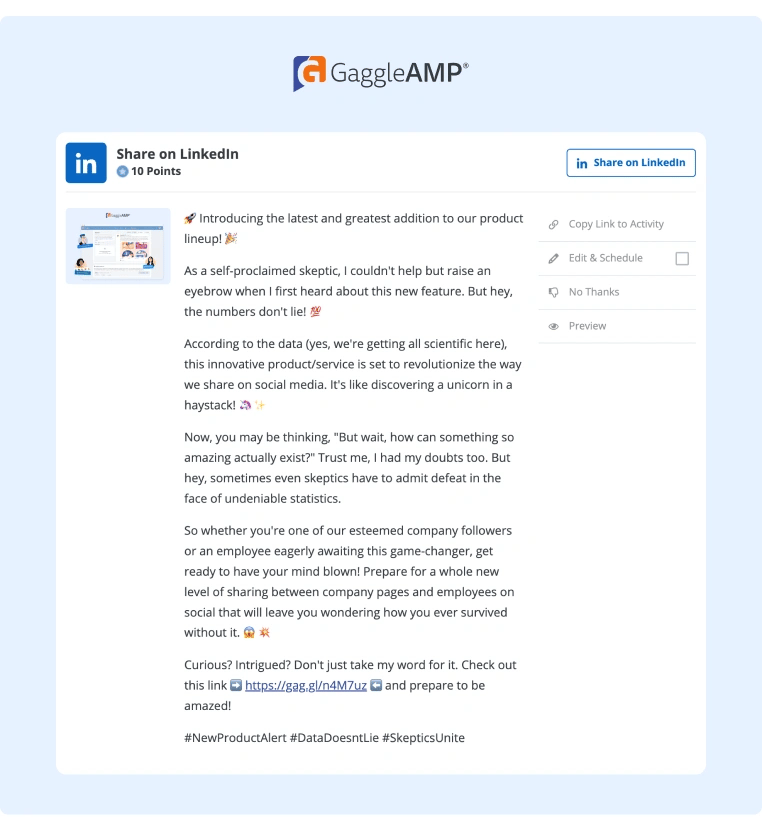
Once you’ve selected the engagement activity, you can add specific instructions like a link to a specific post you want them to engage with. You can even use the AI content writer to write a social media post for the employee.
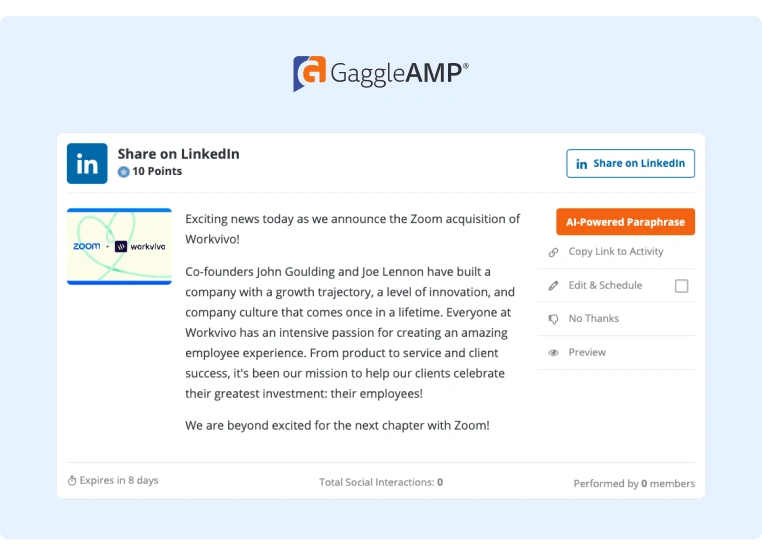
After you complete the engagement activity, you can assign it to a specific employee or a group of employees (like executives or the marketing team).
Employees then receive a notification when you assign the activity. When they log into their Gaggle, they’ll see a list of all the engagement activities you’ve assigned. They can either edit the posts or simply approve them and schedule them for publishing.
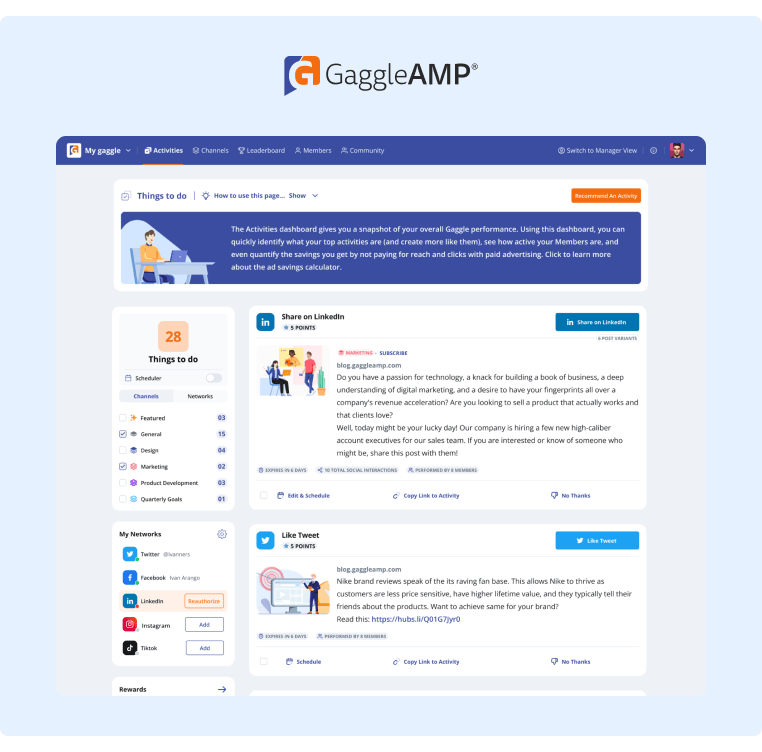
You can also track the performance of each campaign in the analytics dashboard. This makes it easy to see which topics and employees earned the most engagement so that you can iterate future campaigns based on the top performers.
In fact, there’s even a benchmarking dashboard that allows you to gauge your program’s performance against similar sized employee advocacy programs.
It’s also easy to track employee participation as the public leaderboard ranks employees by their engagement participation. This adds friendly competition to further encourage employees to participate in the program and it allows you to reward the most engaged employees.
To see for yourself how GaggleAMP can aid your user generated content efforts, you can schedule a demo today.
Taggbox: General User Generated Content Platform
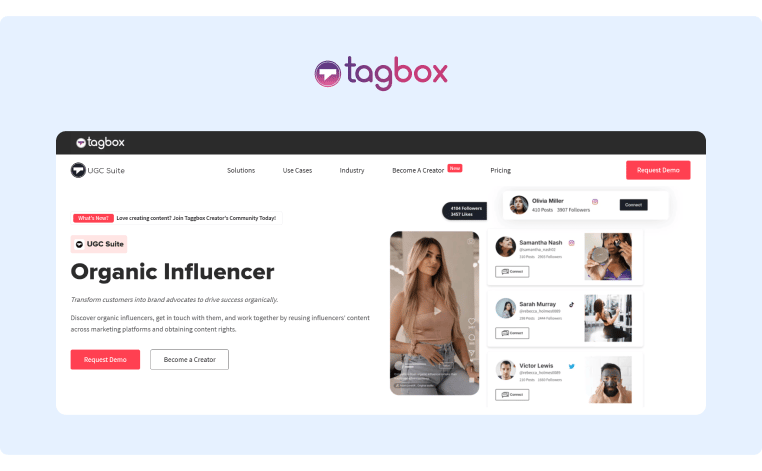
Source: Taggbox
Taggbox is a full user generated content platform that allows you to identify organic influencers to collaborate with, store content assets, and manage content usage rights.
To identify organic influencers, you can sort by niche and filter by follower count, geography, and other metrics.
Once you identify an influencer you want to collaborate with, you can connect with them directly inside the platform. The platform also allows you to store content assets in one individual place and publish them directly to your social media accounts.
Finally, it has a rights management solution that allows you to send UGC rights requests in bulk from a simple Chrome extension.
Insense: Paid Social User Generated Content Platform
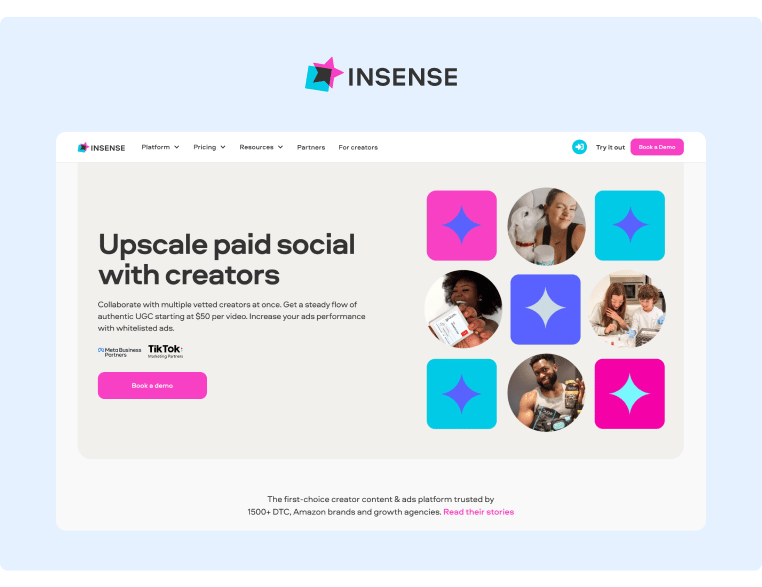
Insense is designed specifically for ecommerce brands that want to collaborate with influencers to create user generated content for paid ad campaigns.
To use the platform, you can fill out a campaign brief that defines the campaign objectives, who your ideal audience is, and the budget. Then, they match you with potential influencer partners.
You can filter the influencer matches by category, age, gender, location, and other metrics, and then connect with them directly inside the Insense platform. They currently have over 20,000 vetted creators on the platform and specialize in beauty, food and beverage, pets, home and garden, sports and fitness, and other DTC industries.
In addition, Insense allows you to manage the entire campaign directly inside the platform, from chatting with influencers and storing campaign assets to rights management and influencer payment.
Start Your User Generated Content Strategy Today
As you can see, user generated content is a highly effective form of content marketing, but it can be challenging to encourage external users to create content about your brand.
To get started, ask your internal employees to share content about your brand and their experience as an employee.
To easily manage your internal advocacy program and track employee participation, consider using a platform like GaggleAMP. It allows you to assign engagement activities to employees at scale, and your employees can easily complete and schedule the activities directly inside their personal Gaggle. It also tracks participation, total engagement, and the ROI of your advocacy efforts.
To learn more, you can schedule a demo of GaggleAMP or try it out for free today.

